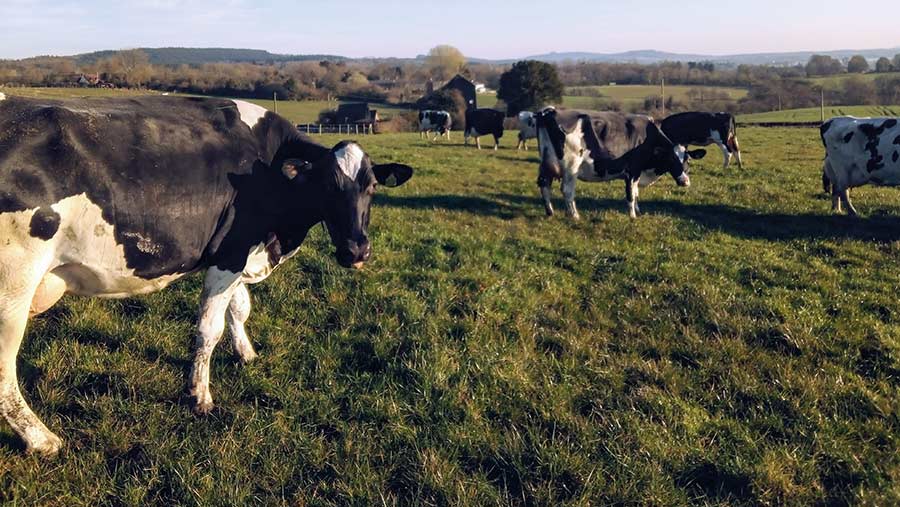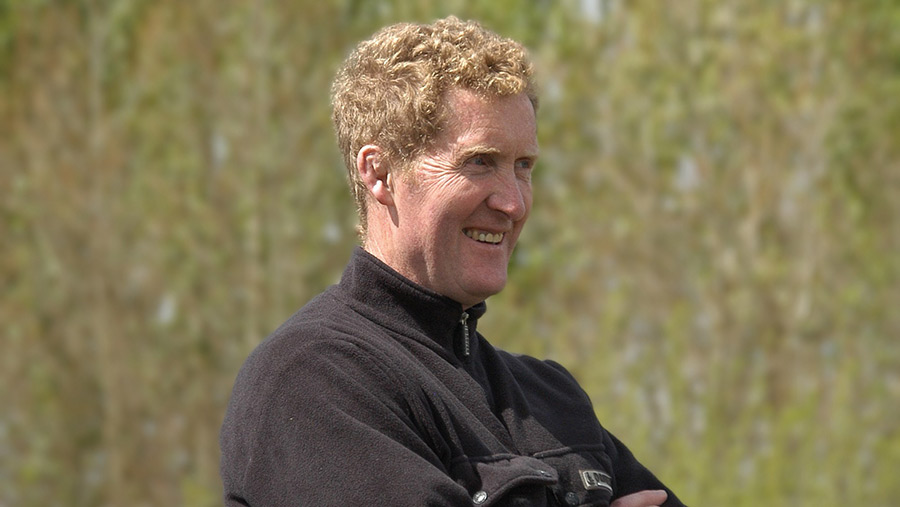Why cutting concentrates is key to more milk from forage
 © Keith Davis
© Keith Davis Challenging milk from forage production saved £20,000 a year when Daniels Farm introduced a multicut silage system.
But it took a milk price crash to fully unlock the potential of forage for dairy farmer Keith Davis, by giving him the confidence to cut concentrates.
See also: How Staffs dairy gets high robot visits with low cake costs
“In 2014, we were feeding 3.1t of cake, but getting only 16p/litre. When the milk price was so low, we couldn’t justify concentrates,” he says.
“I knew I had to do something and realised we could get more milk from forage with multicut, and planned to do it that year.”
The farm had routinely made silage with metabolisable energy (ME) of 11MJ/kg dry matter (DM) for the 120-cow Holstein herd at Daniels Farm, Blakeney, Gloucestershire.
However, Mr Davis realised that clamping leafy, high-quality grass had the potential to produce silage of 12MJ/kg ME.
He also knew that simply feeding higher-quality silage would not produce enough extra milk to repay the investment in cutting grass more regularly. The benefits are marginal, he says.
Real savings would only come from cutting concentrates to stimulate cows to eat more forage. He admits this took some courage to do.
“It’s easier when times are tough, but we should be doing it when things are hunky-dory, to be efficient and profitable,” he says.
Farm facts: Daniels Farm, Blakeney, Gloucestershire
- 52ha (128 acres)
- Maize and grass
- 11-ha (27-acre) grazing platform
- 115 Holstein cows
- Two milking robots
- Calving in 12 weeks from 10 July
- Average lactation yield of 10,750 litres at 4.73% fat and 3.6% protein
- 5,000 litres from forage
- 2.75t concentrates a cow a year
Reducing concentrates: Finding the sweet spot
Concentrates had already been reduced in 2010 when the farm switched to robots: removing them from the total mixed ration (TMR) to be fed at milking was necessary to stimulate robot visits.
The feed rate dropped from 0.35kg/litre to 0.31kg/litre for production above maintenance plus 12 litres, meaning up to 12kg/day of cake was fed in the robot.
This challenged the cows a bit more and milk from forage rose from 2,550 to 4,000 litres, and yield from 10,000 to 10,500 litres.
To cope with the poor milk price in 2014 and get the cows to eat more of the higher-quality forage he was now producing with a multicut system, Mr Davis slashed feed rate to 0.26kg/litre.
“We really went for it. We fed 1.5kg a head of soya and 1.5kg of rape in the TMR, with grass and maize in a 50:50 DM ratio and a maximum 10kg/day in the robot.”

Keith Davis now clamps five cuts in a year, and sometimes six © Keith Davis
This approach saved 350kg a cow a year of concentrate – worth £20,000 across the whole herd.
Since then, he has experimented further with concentrate input, going as low as 0.23kg/litre, but says this cost more in lost more milk than in cake saved.
The sweet spot, he thinks, depends on cow type and milk price. Today he has settled at 0.26kg/litre, or 2.73t a cow, for maintenance plus 12 litres as the optimum.
“Nearly all our silage is now 12MJ/kg ME. We’re producing 10,750 litres a cow and almost 5,000 litres are from forage.
“We could go higher, but we won’t get extra litres of milk – it will be milk solids produced from forage,” he says.
Grazing contribution
Keith Davis’s Holstein herd rotationally grazes 11ha (27 acres) between March and October.
Milk from grazed grass is 1,030 litres – not huge, he says, but it contributes to the 5,000 litres from forage.
To encourage cows to have an edge to their appetite, he has trained a camera on the feed trough and worked out how much to feed, so that the trough empties two hours before turnout.
Healthier cows
Over the past six years, butterfat has risen from 4.4% to 4.73% and protein from 3.5% to 3.6%, totalling 922kg a cow.
As the farm is now on a cheese contract, paying 3.78p/1% fat and 7.5p/1% protein, Mr Davis says this is valuable extra income.
Further benefits to reducing concentrate inputs include healthier cows. “Digestive-related disorders such as acidosis and left-displaced abomasum went away.
“Dry matter intake of forage has risen from 16.5kg a cow a day to 17.5kg a cow a day and we have pretty much stabilised this.”
The extra cost of clamping good-quality silage to get milk from forage at Daniels Farm is £2,000/year.
This is the cost of one extra cut, as the farm now routinely clamps five cuts and sometimes six.
Although individual cuts are light, Mr Davis says he makes just as much silage – and sometimes more – because by starting earlier, he can take three cuts before a drought hits.
Further changes to boost forage quality include a switch to maize varieties with higher digestibility to clamp maize silage that matches the ME value of the grass silage.
Milk-from-forage mindset
The challenge for the farm now is growing enough forage to match the high intakes. Mr Davis is reluctant to replace forage with cake, opting instead to drop from 120 cows to 115.
“Milk from forage is a mindset: if you don’t try to get it, you won’t,” he says. “Yet you can become very interested in how you can challenge it.
“At the end of the day, it’s all about making money, and now is an important time to challenge this as concentrates are going up and milk price is coming down.”
